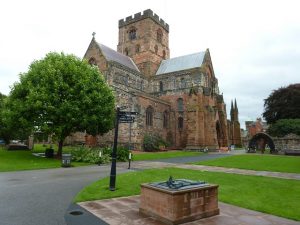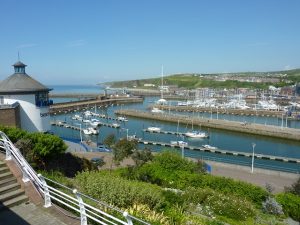Featuring the best attractions in North Cumbria (beyond the Lakes) that are visited by Lake District transport services
The Lake District and Cumbria are home to some of the best scenery and visitor attractions in the country. Outside of the Lake District National Park, north Cumbria has plenty of historic attractions, a picturesque coastline and various popular towns which can provide accommodation and onward travel connections to the Lakes.
There are various bus and train services through the area which will transport you to all of the popular attractions described below. Only attractions that are visited by Lake District transport services are included.
Each attraction includes a brief description, photograph, link to website (where available) and any facilities such as shops, cafes and toilets. Public transport services that stop nearby (within 1 mile) are listed and the location of each stop in relation to the attraction is described. Further information on each transport service, including route maps, timetable links and other attractions visited on route, can be found by following the transport service link.
Most of the towns listed have extensive local bus services but only those that have Lake District connections are included.
North Cumbria beyond the Lakes
Attractions summary
Select attraction for further detail
* Carlisle – Historic capital of Cumbria and the only city within the county
* Cockermouth – Attractive market town at the north west edge of the Lake District
* King Arthur’s Round Table – Prehistoric henge just south of Penrith
* Maryport – Historic industrial town and harbour on the west coast of Cumbria
* Mayburgh Henge – Prehistoric henge just south of Penrith
* Penrith – Market town and transport hub at the north east edge of the Lake District
* Rheged – Large indoor visitor centre just outside Penrith
* Whitehaven – Historic industrial town and harbour on the west coast of Cumbria
* Workington – Historic industrial town and port on the west coast of Cumbria
North Cumbria beyond the Lakes - Attractions Map
Select icon on left side of top map bar for map key
North Cumbria beyond the Lakes - Attractions
Carlisle city

Capital of Cumbria and the only city within the county, historic Carlisle is an interesting place to explore with a turbulent past. A settlement was established in Roman times at this important crossing of the River Eden and Hadrian’s Wall. During the Middle Ages, the border settlement frequently passed from English to Scottish rule as the two countries fought for control.

The impressive Carlisle Castle is over 900 years old and has been the focal point of many historic battles. It is now open to the public and includes the Cumbria Museum of Military Life. Across the road is the interesting Tullie House Museum & Art Gallery which tells more of the local history. Further towards the city centre are some wonderful attractions including Carlisle Cathedral, Guildhall Museum, St Cuthbert’s Church and the old West Walls. The city centre itself has some attractive buildings and a good pedestrianized shopping area.
The bus station and the railway station are both in the city centre, a short walk from each other. Only bus services that visit Lake District attractions are included.
Cockermouth town

Cockermouth is an ancient market town, formerly a Roman settlement at an important road and river crossing. The nearby Roman Fort of Papcastle is testament to the Roman activity in the area. The Rivers Derwent and Cocker meet in the town and between them drain a huge area of the northern Lake District. The attractive town was devastated by flood waters in 2009 and 2015 when several feet of flood water flowed along the main street. Since then the town has largely been restored and improved and is well worth exploring.

The pretty main street has a number of interesting shops and Georgian buildings including Wordsworth House where the famous poet William Wordsworth was born in 1770 and spent much of his childhood. The National Trust property is open daily from Easter to November, except Thursdays & Fridays. At the other end of the main street, off Castlegate, is Cockermouth Castle, some of which dates from the 12th century but is privately owned and rarely open to the public. Other attractions include Castlegate House Gallery, Market Place and some pleasant riverside walks.
Buses stop at various locations in the town including Main Street in the town centre. Only bus services that visit Lake District attractions are included.
King Arthur's Round Table

Despite the name, the prehistoric henge of King Arthur’s Round Table has nothing to do with the legendary King Arthur, preceding his time by a few thousand years. There isn’t much to see now apart from the circular ditches which are interesting but unfortunately not quite complete due to the adjacent road covering part of it. It is believed there was at one time a stone circle but that has long gone. This site and nearby Mayburgh Henge were part of a select few English sites included in the Ancient Monuments Protection Act of 1882. The site is in the village of Eamont Bridge, just over 1 mile south of Penrith town centre. The Beehive Inn and Crown Inn pubs are adjacent but no other facilities.
Buses stop adjacent to the attraction. Only bus services that visit Lake District attractions are included.
Nearby are the historic attractions of Brougham Hall, approx 0.5 mile walk, and Brougham Castle, approx 1.5 mile walk, along the B6262.
Mayport town

Maryport is a typical West Cumbrian coastal town with an interesting history and a number of attractions for visitors. It mostly dates from the 18th century when there was a local coal mining boom. Similar to nearby Whitehaven, the town was developed with a grid patterned street design centred on the busy harbour and on Fleming Square which remains an attractive cobbled square surrounded by Georgian architecture. The industry is long gone but the pleasant harbour area has been redeveloped in recent years and is worth exploring. You can learn about the interesting history of the area at The Maritime Museum and nearby is The Lake District Coast Aquarium which is a good family attraction. The Wave entertainment centre has various attractions and a cafe.

Long before the coal boom, the town was also a Roman settlement with defences which extended from Hadrian’s Wall down the west coast. On the hill at the northern end of the town are the remains of a Roman Fort adjacent to the Senhouse Roman Museum which contains interesting Roman artefacts. The Roman Fort area has some wonderful views across the harbour and out to sea towards southern Scotland.
There is a coastal park immediately to the south which provides walks along the pleasant coastline and you can also walk some distance northwards from the town along the promenade.
The railway station is on the eastern edge of the town centre. Bus services do not visit Lake District attractions from Maryport so are not included.
Mayburgh Henge

The prehistoric Mayburgh Henge is probably related to nearby King Arthur’s Round Table, with both estimated to be about 4000 years old. However, this is significantly more impressive. It is estimated that over 5 million cobbles from the local river were used in the construction and it is mind boggling to imagine how much effort was involved. The outer bank is several metres high and approx 100m diameter and provides good views of the surrounding area. A single upright stone exists in the centre of the arena which is all that remains of the original standing stones. This site and King Arthur’s Round Table were part of a select few English sites included in the Ancient Monuments Protection Act of 1882. The site is just outside the village of Eamont Bridge, just over 1 mile south of Penrith town centre. Free access but no facilities on site.
Buses stop nearby on the B5320. Only bus services that visit Lake District attractions are included.
Penrith town

Penrith is a busy market town on the eastern edge of the Lake District. It is an important hub for Eastern Cumbria being at the junction of the M6 and the A66, as well as having a railway station on the main west coast line. The location makes it a busy thoroughfare for traffic, but despite this the town centre retains a certain amount of charm and is worth exploring.

The old town centre buildings are mostly local red sandstone which epitomises many of the buildings in this area. There are plenty of old streets and shops to explore within the town and Penrith Museum, housed within the Tourist Information Centre, will tell you more about the area and its history. The attractive St Andrew’s Church is just off the market square and up the hill from there, opposite the railway station, is the 14th century Penrith Castle which is now in ruins but the remains are interesting and free entry.
Buses stop at the bus station and/or the railway station. Both are within the town centre. Only bus services that visit Lake District attractions are included.
Rheged Visitor Centre

Rheged is an interesting visitor centre with a good selection of attractions for the whole family. It is apparently Britain’s largest grass covered building and the clever design certainly hides it from the surrounding countryside. There are various different shops, childrens play areas, cinemas, exhibitions on the local area and events. There are a few picnic tables and a play area outside, everything else is inside. Entry is free for visitors, with cafes and toilet facilities inside. Open daily.
Buses stop outside the building in the car park.
Whitehaven town

Whitehaven is an attractive coastal town with an interesting history and a number of attractions for visitors. The town grew up in the 17th & 18th centuries with the boom of local coal mining and the port soon became one of the most important in the country for coal export. The Georgian town was largely planned and built during this boom and the grid patterned streets were quite unique at the time. The coal mines eventually closed and the port became redundant but the harbour area has been redeveloped in recent times as a marina and tourist attraction and is worth exploring.
The Beacon museum is on the harbour side and tells the history of the local area. In the town itself the Rum Story attraction tells the darker history of the area and nearby is St Nicholas’ Church which was largely destroyed by fire in 1971 but the tower and pretty gardens are open to the public. Buried here is Mildred Gale, the grandmother of first US President George Washington, who briefly lived and died in the town. Up the nearby hill is St James’ Church which has a beautiful Georgian interior.
The railway station is on the northern edge of the town centre. Bus services do not visit Lake District attractions from Whitehaven so are not included.
Workington town

Workington, like many other local towns, grew up largely around the coal industry and had a significant boom around the 18th century. There were dozens of coal mines in the area, some extended out to sea underground and the town also became a centre for steel making. Although it eventually became a significant port, the old town was on higher ground slightly inland. This old town area, slightly east of the shopping centre, is an interesting place to explore and includes the attractive Portland Square, the striking St John’s Church and the Helena Thompson Museum which reflects the history of the area. Curwen Park contains the impressive ruins of Workington Hall which was the home of the Curwen family who helped develop the area during the boom years. For some retail therapy, the town centre has plenty to offer including Washington Square shopping centre which has a number of popular high street stores.

The River Derwent, which drains much of the north west Lake District, runs through the town and enters the Irish Sea here. The once highly industrial area around the mouth of the river is still an operational port but there is also a reclaimed coastal access area immediately to the south which has good views in all directions, coastal walks and a beach. Views include St Bees Head to the south, northwards beyond the many wind turbines, out to sea towards southern Scotland and the Isle of Man, plus inland towards the Lake District mountains. There are good paths along the cliff tops immediately to the south giving even better views. The beach is mostly stony at high tide but exposes an expanse of hard sand at low tide. This area is approx 1 mile westwards from the railway station.
Buses stop at the bus station in the town centre. The railway station is a short walk away on the western edge of the town centre. Only bus services that visit Lake District attractions are included.




